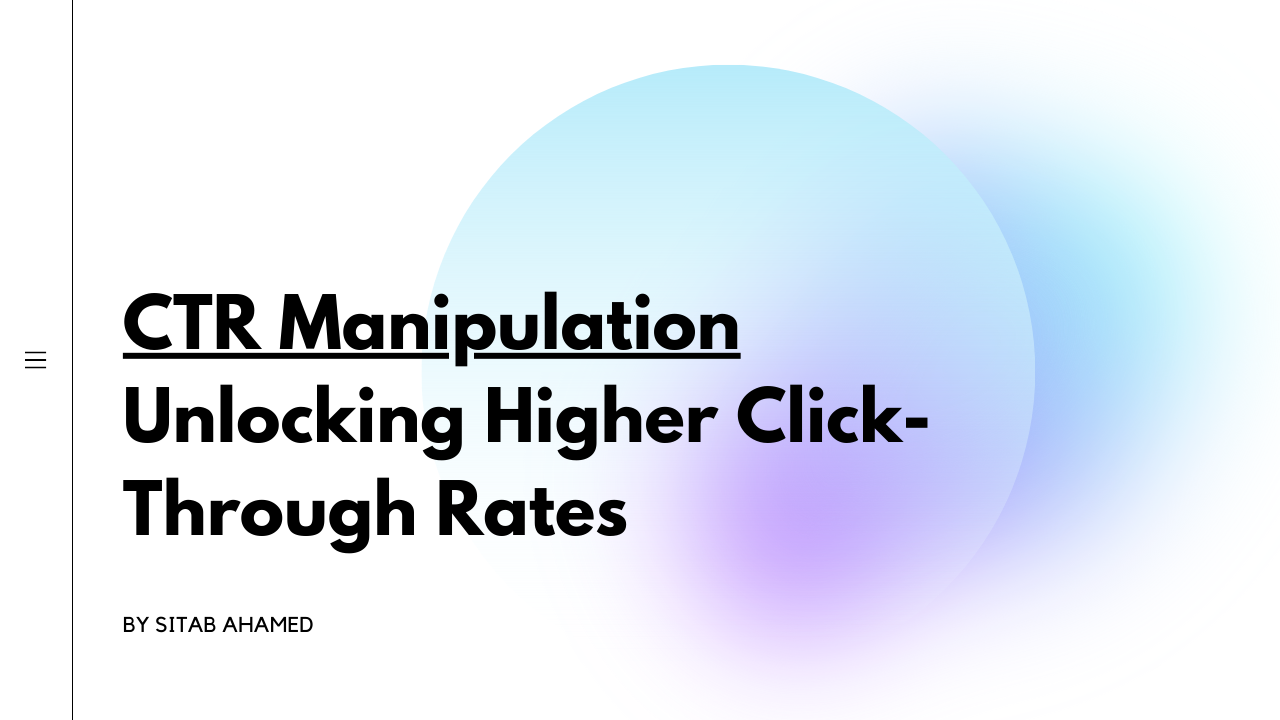CTR Control: A Video Game Changer for Digital Campaigns
The increase of CTR adjustment has undoubtedly transformed electronic advertising and marketing methods, offering marketing professionals with tools to improve engagement and drive traffic properly. Methods such as A/B testing and tailored material have confirmed to generate significant enhancements in click-through rates. As brand names significantly take advantage of these approaches, the ethical implications of such practices require analysis. Balancing the quest of maximized metrics with the need for genuine target market connections positions an essential difficulty for marketers today. What ramifications might this stabilizing act hold for the future of digital campaigns?
Comprehending CTR Control
Although click-through price (CTR) adjustment might feel like a straightforward technique in electronic advertising and marketing, it incorporates a series of strategies targeted at artificially pumping up interaction metrics. This control can take different types, consisting of using click farms, robots, or misleading ad positionings that misinform consumers into clicking. These methods can compromise the honesty of efficiency data, making it challenging for marketing professionals to gauge the genuine effectiveness of their projects.
In addition, CTR adjustment elevates moral problems, as it undermines the transparency of electronic advertising and marketing. The dependence on filled with air metrics can result in misdirected marketing decisions, skewing source appropriation and campaign methods. Subsequently, organizations might spend heavily in channels and strategies that show up successful but do not produce genuine engagement or conversions.

Advantages of Click-Through Rate Optimization
Maximizing click-through price (CTR) is important for improving the efficiency of electronic marketing projects. A higher CTR shows that a larger percentage of individuals are engaging with the material, which can lead to raised site web traffic and much better conversion rates. By improving CTR, brand names can effectively allot their advertising sources to efforts that generate the highest returns.
Among the key benefits of CTR optimization is the possibility for improved ad positioning and lower expenses - CTR Manipulation. Systems like Google Advertisements reward greater CTRs with better ad positioning and lowered cost-per-click (CPC), allowing marketing experts to stretch their budget plans better. Additionally, a well-optimized CTR can boost brand exposure, as greater engagement rates usually correlate with enhanced natural reach

Methods for Reliable CTR Manipulation
To successfully adjust click-through prices (CTR), online marketers can utilize a selection of image source strategic techniques that improve customer involvement and drive traffic. One essential strategy is optimizing ad copy to produce compelling and action-oriented language. CTR Manipulation. Making use of solid call-to-action (CTA) expressions encourages users to take immediate action, raising the probability of clicks
An additional efficient strategy is A/B screening, which allows marketing professionals to compare various advertisement variations. By systematically evaluating performance metrics, they can identify which components reverberate ideal with the target market, therefore improving their approaches for optimal influence. In addition, leveraging aesthetically enticing graphics and succinct messaging can catch interest quickly, making it much more possible that users will engage.

Lastly, optimizing touchdown web pages to make certain a smooth individual experience can decrease bounce rates and motivate additional communication, inevitably promoting higher CTR. By incorporating these strategies, marketing professionals can successfully control CTR to achieve their project goals.
Measuring Success in Digital Projects
Determining success in digital campaigns calls for a clear understanding of crucial performance indications (KPIs) that line up with campaign purposes. KPIs function as quantifiable metrics that aid examine the effectiveness of numerous methods employed throughout the project. Typical KPIs consist of click-through rates (CTR), conversion prices, more information expense per acquisition (CERTIFIED PUBLIC ACCOUNTANT), and return on financial investment (ROI)
To efficiently measure success, it is crucial to develop particular, quantifiable goals at the start of the project. If the key purpose is to enhance brand name awareness, like this metrics such as impacts and engagement prices might be focused on. On the other hand, campaigns focused on direct sales would certainly gain from a much more detailed evaluation of conversion rates and profits generated.
Regular evaluation of these KPIs enables marketing professionals to make data-driven decisions, enhancing their strategies in real-time. Using analytical tools can assist in monitoring efficiency and identifying patterns, permitting swift modifications to boost project outcomes. Inevitably, a comprehensive technique to gauging success not only highlights areas for enhancement but additionally enhances the overall efficiency of electronic advertising and marketing initiatives, driving sustained development and involvement in the lengthy term.
Future Fads in Digital Marketing
Anticipating the future of electronic advertising and marketing reveals a landscape shaped by quick technological improvements and altering consumer actions. As artificial intelligence and artificial intelligence remain to advance, online marketers will significantly utilize these innovations to customize projects at an unprecedented range. Anticipating analytics will certainly make it possible for brand names to prepare for consumer needs, optimizing ad placements and material distribution in actual time.
Moreover, the increase of voice search and clever tools is transforming exactly how customers engage with digital material. Marketers will require to adjust their techniques to guarantee presence across multiple systems, including voice-activated aides. This change necessitates an emphasis on conversational marketing, highlighting engagement via dialogue instead of conventional marketing strategies.
In addition, privacy issues are motivating adjustments in data collection techniques. Transparency and ethical data use will become critical, driving brands to cultivate trust fund and commitment amongst consumers. The ongoing advancement of social media sites platforms will certainly also influence advertising and marketing techniques, with an enhanced emphasis on authenticity and user-generated material.
Conclusion
In recap, CTR control represents a significant development in electronic advertising methods, offering instant benefits with improved engagement metrics. The ethical factors to consider surrounding such methods necessitate a mindful approach to guarantee long-term brand integrity and authentic audience link. By striking an equilibrium between optimization techniques and authentic involvement, online marketers can grow lasting partnerships with consumers. The recurring development of electronic marketing will certainly depend on this fragile interaction, shaping the future landscape of brand-consumer communications.
 Bug Hall Then & Now!
Bug Hall Then & Now! Nadia Bjorlin Then & Now!
Nadia Bjorlin Then & Now! Richard Dean Anderson Then & Now!
Richard Dean Anderson Then & Now! Megyn Kelly Then & Now!
Megyn Kelly Then & Now! Nicholle Tom Then & Now!
Nicholle Tom Then & Now!